On May 11, 2015, Ellen T. Harris (President of the American Musicological Society and Class of 1949 Professor Emeritus in Music and Theater Arts at the Massachusetts Institute of Technology) spoke at the Academy about Handel’s life and his inner circle of friends. Harris’s slide presentation and discussion was followed by a performance by members of the Boston Early Music Festival Vocal and Chamber Ensembles. The program, which served as the Academy’s 2021st Stated Meeting, included a welcome from Jonathan F. Fanton (President of the American Academy) and a remembrance of Academy members who died during the year read by Arthur M. Jaffe (Landon T. Clay Professor of Mathematics and Theoretical Science at Harvard University). The following is an edited transcript of Ellen Harris’s unscripted talk.
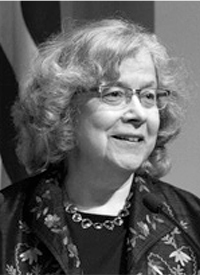
Ellen T. Harris
Ellen T. Harris is President of the American Musicological Society and Class of 1949 Professor Emeritus in Music and Theater Arts at the Massachusetts Institute of Technology. She was elected a Fellow of the American Academy in 1998.
My talk tonight stems from my most recent book, George Frideric Handel: A Life with Friends, in which I try to understand Handel, the man. We tend to think of him as he is portrayed in Thomas Hudson’s famous portrait (Figure 1), in which the rather portly Handel is wearing brocade, silk, ruffs and lace, and, most important, a big wig. In a literal sense, Handel was, in fact, a bigwig.
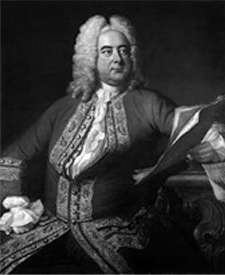 |
| Figure 1: Thomas Hudson, Portrait of George Frideric Handel, 1748-1749. Image courtesy of the Staats- und Universitätsbibliothek Hamburg Carl von Ossietzky. |
Unexpectedly, Handel’s 1750 will was the best starting point I found for learning about the musician and the community of friends and intimates surrounding him. He left bequests to a number of friends, none of whom were known to Handel scholars. It seemed very strange to me that in the two hundred and fifty years since Handel’s death not one researcher had investigated these individuals, who were referred to simply as the mysterious people appearing in Handel’s will. I suspected that they could emerge as more fully realized figures.
The will led me ultimately to six colleagues and acquaintances of Handel (some of whom are not actually named in the document). One of these was James Hunter, who received a bequest, a significant portion of which unfortunately remains unreadable despite the most advanced efforts to decipher it. Another was Joseph Goupy, one of Handel’s colleagues who was best known as a painter of copies of artistic masterworks for the aristocracy. (First-rate painters who specialized in reproductions were very much in demand in the eighteenth century.) But Goupy had a huge falling-out with Handel and was not included in the will. Mary Delany, who has in recent years become well known for her flower mosaics, all of which are preserved at the British Museum, is another Handel colleague who fascinated me in the course of my research. Delany began making her mosaics at age seventy, after Handel’s death, and hoped to make one thousand; she ended up creating about 980. Other associates of Handel included Anne Donnellan, one of the legatees who lived nearby, and Elizabeth Mayne, who married the lord of the manor in Teffont Evias, near the city of Salisbury.
How did I find out about Handel’s mysterious colleagues, and where did I go to retrieve information about them? I spent a lot of time in historical archives, looking through documents for evidence and material about their personal lives. Their own handwritten wills are preserved in the United Kingdom’s National Archives, based in Kew. The legal (Chancery) copies, which function like modern typed copies, can be purchased online, but in order to see the original handwriting, which can be very useful, it’s necessary to go to the Archives.
Legal documents also reveal an enormous amount of information. Bills of complaint contain striking content, and depositions are especially interesting. Like captured speech, they are as close as we might get to the gossip of the time. In the course of a deposition, people tended to reveal an enormous amount of information in response to questioning (not all of it relevant to the case). All of that material was invaluable to my effort to learn about these characters in depth.
Bank of England documents, in particular, were essential to my work. Not only did I have Handel’s records, but I also had the bank accounts of many of his friends. The Bank of England has preserved all of its documents back to its founding in 1694. Both my students and my colleagues sometimes ask me why I’m spending time with documents in the vaults of the Bank of England. For one, they’re beautiful: these are stunning, handwritten documents of the time. There’s a Dickensian feel to a lot of this research, though much of the material predates his novels by one hundred years. The image of Bob Cratchit of A Christmas Carol sitting on his clerk’s stool and writing often came to mind. Second, if you want to know about someone, where better to look than in their financial records? I ask my students, if I had your credit card record and your bank accounts, what would I learn about you? They then understand!
I also spent a lot of time with fire insurance records. After the Great Fire in London in 1666, fire insurance became a coveted commodity. I consulted James Hunter’s policy – created with the Hand-in-Hand Fire and Life Insurance Society – on his dye house in Old Ford (Figure 2). I learned a great deal from reading in the margins. Hunter owned not just a single house, but a business with many buildings: dye houses, still houses, carriages and servants’ rooms, which, taken together, constituted a factory. I could glean, then, that Hunter was not himself up to his elbows dying linen in vats, but instead delegated work to his company’s workers. Fire insurance records can tell you other essential information about these residences, such as which rooms have wainscoting or how many chimneys a house had (an important piece of information for fire insurance). After examining Hunter’s insurance record, I was able to create a fairly accurate facsimile of what Hunter’s dye house would have looked like.
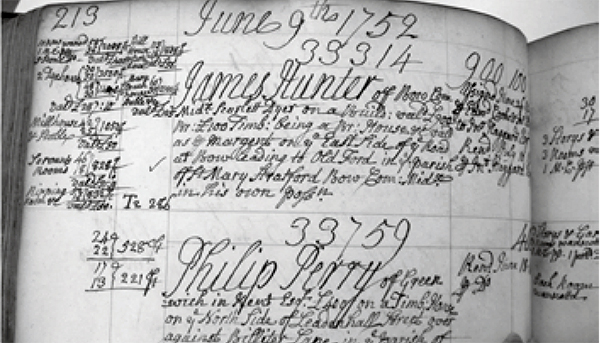 |
| Figure 2: James Hunter’s fire insurance policy, renewed in 1752 with the Hand-in-Hand Fire and Life Insurance Society. Image courtesy of London Metropolitan Archives, London. |
Finally, I relied on art auction catalogs, some of which featured beautifully handwritten records about buyers and prices. Unknown to many, Handel had a significant art collection that included “a large landscape and figure” by Rembrandt. Handel’s name is written in the catalog in red, indicating he was the purchaser. The authenticity of the “Rembrandt” cannot be confirmed. All of Handel’s paintings were auctioned after his death, and we do not yet have enough information to trace his collection.
Combing through these records, catalogs, and bank documents, I got the sense that Handel and his friends formed a distinct neighborhood. All of these people lived in very close proximity to one another. In 1723, Handel moved to 25 Brook Street, close to Bond Street, Tiburn Road (now Oxford Street), and Grosvenor Square (where the American Embassy stands today). For some time in the late twentieth century, there was a chance that Handel’s house would be torn down, but in 2001, it opened as the London Handel House Museum. (Much effort went into preserving this house as a museum. Operations began on the upper three floors, thanks to a “peppercorn rent,” before the museum raised enough funds to buy the ground floor.)
The map of the neighborhood around St. George Hanover Square (Figure 3) gives an approximation of where Handel’s friends lived. They moved around a great deal. In the small area of this map, Delany had two different residences; Donnellan had four; Goupy had three; and Palmer had two, including a big double house on Curzon Street. Handel is the one stationary figure. Once he moved into the house on Brook Street, he remained there for the rest of his life, dying there in 1759. In contrast, Goupy first took leased residence on Bond Street, but as he rose in station, he moved to a much better address on Savile Row. When he began working for Frederick, Prince of Wales, he moved to a beautiful house at 97 Park Lane, just down the street from Handel.
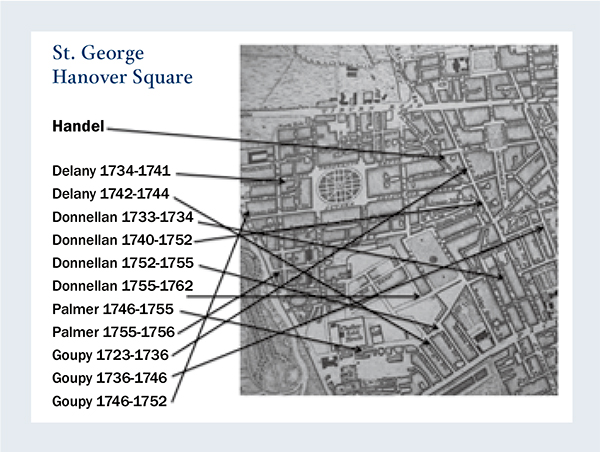 |
| Figure 3: Residences of Handel and his friends, based on John Pine’s and John Tinney’s Plan of the Cities of London and Westminster and Borough of Southwark, 1747. Image of map courtesy of the Westminster Archives Centre, London. |
Through the surviving documents, I found, not surprisingly, that playing music was one of the main activities that Handel’s inner circle enjoyed. Elizabeth Mayne (Elizabeth Batt before she married) was a harpsichordist, noted for her playing. I tracked down her early keyboard book from 1704 in the British Library, and in it, I found a lot of fascinating music from the time, such as incidental music by Purcell adapted for keyboard and excerpts from English opera. Batt’s name is carefully written out in gothic letters on the cover of the book. She began using it when she was nine.
Mary Delany, who much of her life lived right up the road from Handel on Brook Street, was, like Elizabeth Mayne, also a fine harpsichordist. She studied Handel’s keyboard pieces and suites. Delany hosted many music parties, often attended by Donnellan, also a friend of hers, and sometimes by Handel. In one of her letters about these events, she describes Handel attending and how he was in a good mood, which suggests to me that he wasn’t always in one. She relates that Handel performed with one of his featured prima donnas, but stayed until the early hours of the morning accompanying all the ladies in attendance.
Handel’s friend Anne Donnellan was widely known as a singer. There are letters from Delany about excursions on the Thames River, during which other boats crowded around to hear Donnellan’s voice. In another story, it was suggested that Lord Burlington would fly to her feet if ever he heard her sing “Verdi prati” from Handel’s Alcina.
In Figure 4 we see Donnellan stand in the middle of a particularly revealing Hogarth painting of the Wesley family, ancestors of the Duke of Wellington. The young girl is a dancer, and the older daughter is a keyboard player. The father holds a violin in his lap. The mother is giving the beat. They are poised to begin, and looking at Mrs. Wesley. Donnellan’s house at the base of Berkeley Square on Charles Street has survived. (There’s a pub just one door down, which was also in existence at the time, and I do like to speculate on whether Anne Donnellan or Handel ate there.)
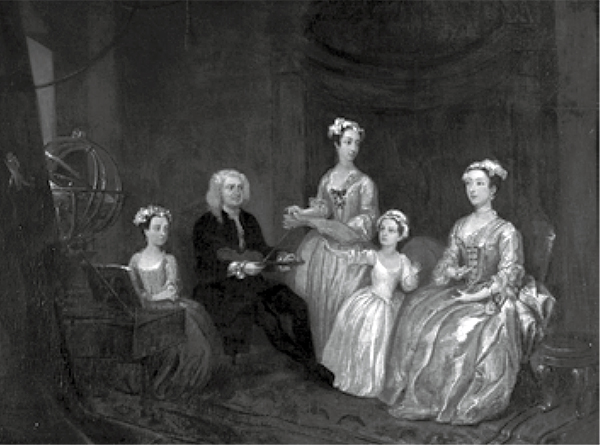 |
| Figure 4: William Hogarth, The Wesley Family (with Anne Donnellan), 1731. Wellington Collection; Stratfield Saye Preservation Trust. Image courtesy of Stratfield Saye Preservation Trust. |
Probing the lives of Handel’s friends has helped round out certain difficult periods in Handel’s life. For instance, at the very end of his life, Handel began losing his sight; by 1754, he was completely blind. This loss ended his compositional work, but not his ability to perform music on the keyboard. His friends continued to ask him to play instruments in their homes, and he continued playing up until his death in 1759. For instance, Delany reports in a letter how in late 1755 Anne Donnellan had him try out her new Jacob Kirkman harpsichord at her house on Charles Street at the base of Berkeley Square, which still survives. In a combination of historical and financial sleuthing, I found Donnellan’s financial records at Goslings Bank, a private bank that many women used for the convenience of having a financial advisor. And within those records I found the record of her purchase of the harpsichord from Jacob Kirkman for nine pounds and nine shillings in January 1756. This is a wonderful example of how documents can come together to support one another.
When Handel first arrived in London, late in 1710, before he had his own house and had built all of these friendships in the neighborhood, he sometimes performed at public concerts held by Thomas Britton. Britton was a dealer in small coal, or charcoal, who is described as walking through the streets of London, in a blue smock with a sack of small coal upon his back, crying out his wares on the two notes that formed an octave. Above his shop, he had a music room where he held concerts. Many foreigners came to these concerts to get a sense of the cultural scene in London. I’m certain that Handel was one of the foreigners attracted to this scene.
I like to imagine that at Britton’s concerts Handel played his Trio Sonata in F, one of only two trio sonatas that Handel is known to have composed before he came to London. This trio was written for two violins, cello, and harpsichord, and it is a sassy little piece. It would have introduced Handel to his London audiences in a wonderful way.
Listening to the trio, you get the sense of a children’s game, of playing: notes that are approaching, then running away; or are more like objects, tossed back and forth. What is astonishing about this trio is that once begun, Handel doesn’t continue along with this playful progression; he moves away from it, and slides into an unexpected chromatic passage before returning to the chase. As soon as this return accelerates up to full speed, Handel suddenly cuts it off as if with a guillotine. There’s a long silence before the piece picks up again with a new chromatic passage and moves to a close.
One imagines this composition might have shocked the English auditors, who learned quickly that Handel’s music was not well-behaved. With a piece like this trio sonata, the young Handel would have introduced himself as an innovative, risk-taking composer. His music might not be shocking to us now, since we have learned to relish the striking juxtapositions and silences he built into his scores. But if you were hearing Handel’s music for the first time, and his early work at that, it would have likely signaled to you that he was a figure well worth paying attention to. You would never be lulled into an expectation of what would come next.
Besides being neighbors, playing music with one another, and visiting each other’s houses, Handel’s friends had another point in common: none of them had conventional marriages. Handel never married; neither did Goupy, nor Donnellan. The other friends had marriages that were forced on them, or they made “clandestine marriages” where the couples effectively eloped without any provision from their families and were then largely ostracized for doing so.
Elizabeth Mayne was the exception, as the only friend who had anything resembling a conventional marriage, negotiated by the participating families through a marriage contract that outlined a proper exchange of status and money. At this time, marriages more resembled mergers and acquisitions than a love match. Despite the conventional preparations, however, Elizabeth Mayne’s husband, it turns out, had murdered a woman in Essex some years earlier. There is certainly something unconventional about that. One of the delights of my research was that the Mayne family didn’t know this fact and they eagerly asked for all the documents. So my research has revealed that having a murder in your family three hundred years ago turns out to be an exciting event – at least it seemed to be in this case.
Some of the other friends had much more difficult marriages. For instance, Elizabeth Palmer married Ralph Palmer, who was related, along with his family, to the aristocratic Verney family by marriage. Elizabeth, whose maiden name was Peacock, was the child of servants, and this fact did not sit well with the Verneys. Lord Verney, in particular, was extremely unhappy about the marriage, and all sorts of legal documents were taken out to separate Elizabeth Peacock from any portion of the Palmer inheritance.
In another case, we have James Hunter, the scarlet dyer. He was the third son of a family of Huguenot traders, though he did not expect to get very far from that position. His oldest brother was sent to Aleppo to work for the Levant Company as an apprentice, but as the third son, James was not given a comparable opportunity. So, he decided to take things into his own hands, and on December 17, 1728, at the age of seventeen, he set about marrying. To avoid asking permission or having the banns announced for three weeks before the marriage, Hunter acquired a marriage license from the Bishop of London, in which he falsely declared he and his bride-to-be were both twenty-one years old. After their wedding in Somerset Chapel, they were largely separated from family and left to manage on their own. Hunter tried to make a living as a trader in the city, but ran into financial difficulties. He was sued by the Bank of England, and, ultimately, was declared bankrupt, a privilege allowed only to international traders in order to help them get back on their feet. Other defaulters were declared insolvent and sent to debtor’s prison.
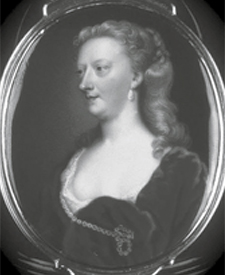 |
| Figure 5: A miniature portrait of Mary Delany, one of four portraits in a friendship box, by Christian Friedrich Zincke, c. 1740. Image courtesy of the National Portrait Gallery, London. |
Among Handel’s friends who married, Mary Delany offers, in some ways, the saddest case (Figure 5). At the age of seventeen, she was forced to marry a man who was her uncle’s political crony. He brought a certain kind of stature to the family, along with votes in Parliament. Mary hated him. She wrote a great deal about her feelings, mentioning, vividly, that on her wedding day, never was woe dressed out in gayer colors. As she was led to the altar, she wished from her soul she had been led, as Iphigenia was, to be sacrificed. Mary’s marriage lasted until her husband died, seven years later. As a young widow, she moved to Brook Street, only a few blocks from Handel. At the age of forty-four, she married Patrick Delany, the love of her life, though her family disapproved and thus withheld inheritances and family gifts from her.
Looking closely at the marriages of Handel’s friends might give us some insight into what Handel observed around him and drew inspiration from. Marriage played an enormously important role in all of the operas he wrote. In conventional narratives, true love faces obstacles, but ultimately prevails in marriage. Two of Handel’s operas from the early 1720s, Radamisto and Rodelinda, revolve around marital relationships. In Radamisto, the title character and his wife Zenobia are in danger of being taken prisoner. Zenobia pleads with Radamisto to kill her rather than allow her to be taken captive, but he can’t bring himself to comply. In desperation, she leaps off a cliff.
Like Hamlet, Radamisto can never quite decide what is the right thing to do. After Zenobia’s desperate action, he stands paralyzed and sings the aria, “Ombra cara,” calling out to her, Oh, beautiful shade. Rest happily, he continues; after I take revenge, I will fly to you. Some interpreters of Radamisto deem this aria an inappropriate response: Radamisto should either feel more agitated or sing a heartfelt lament. However, I think the aria captures exactly the right tone. Radamisto is stunned, and the aria depicts that perfectly.
As Radamisto sings long, sustained lines with little melodic movement, the orchestra depicts his submerged emotions in twisted, contrapuntal and chromatic lines that wash over the listener in a flood of sound. That is, the passionate depth of the aria emerges not from the voice, but from the melodies of the orchestra, from which Radamisto is wholly cut off. The power of the scene is derived in part from an unyielding divide between the stark vocal line and the orchestra’s roiling emotion.
Generally, when Handel composed operas about true love, or about companionate marriage, he was writing about something that was desired, but did not often exist, in contemporary culture. Elizabeth Robinson Montagu remarked that talking about marriage based on love was a fitter conversation for an imaginary Utopia than the current state of Great Britain. Given her own experiences, Handel’s friend Mary Delany felt strongly that marriage should be based on choice. “I have no notion of love and a knapsack, but I cannot think riches the only thing that ought to be considered in matrimony,” she is quoted as saying.
Unlike Handel’s earlier operas based more on Montagu’s Utopian dreams, Imeneo and Deidamia, the last two operas Handel wrote, are about couples not finding the love they desire. They are the only two of Handel’s operas in which the cultural period is accurately represented, and the listener gains a good sense of what marriage was like in the eighteenth century. Women could be forced to relinquish a love relationship, forced to marry, or both. Handel’s last two operas represent the first and only time this theme is touched upon in his work.
In Deidamia, Achilles dresses up as a woman to avoid being shipped off to the Trojan War. Ulysses arrives with a large platter of jewels, a sword, and a helmet. He asks the lovely women gathered to pick something they would like. Achilles is outed when he chooses the masculine tools of war. When he leaves to join his comrades, Deidamia is left desolate.
She turns on Ulysses, and reproachfully cries, “You have made me unhappy, and you’re proud of that?” There is no orchestral introduction; the aria just begins with the voice floating in space. The orchestra responds with a plaintive echo, one octave below what Deidamia has sung. It is as if she is singing into a void. Deidamia receives very little in return from the orchestra or Ulysses; and she certainly doesn’t get back Achilles. She then pronounces vengeance on Ulysses: may he face storms; may they sink his ships; may he never get what he desires; may he never return to his homeland. Unlike Radamisto, Deidamia is deeply engaged and emotionally connected to the scene as her emotions shuttle back and forth.
For people who know Baroque opera and know the structure of da capo arias, returning to the beginning is the norm. But that return, to the head of the piece, doesn’t happen in Deidamia’s aria. Deidamia expresses her unhappiness, followed by an explicit desire for vengeance. Though her “I am very unhappy” followed by her subsequent “I’m very vengeful” sounds as if it should develop into a da capo, something the text seems explicitly to allow, Handel’s setting, with its continuing vacillation, gives the clear sense that her emotional instability will continue. There is none of the closure found in a traditional da capo aria.
Another vital cultural issue of Handel’s time found in his operas and later oratorios is illness, which, of course, played a large role in eighteenth-century culture, as it did in the stories of many of Handel’s friends. The two most common causes of death listed in the bills of mortality from this period were convulsions and fever. Hallucinations that attended fever were a particular concern as doctors needed to determine whether these were fever-induced or if the patient was, in fact, mentally ill. When Handel began in 1738 to have a number of what were called paralytic attacks, some of the people around him worried about his mental stability, which was, however, never in serious doubt. In contrast, we have the medical records of a “mad doctor” consulted by Joseph Goupy for a person in his household who had to be confined.
Perhaps drawing from personal experience, Handel wrote a number of important scenes of madness: in his opera Orlando, in the oratorio Saul, and in the oratorio Hercules. In Admeto (1727), Handel depicts the hallucinations of physical illness. The story is well known. The dying King Admetus can only be saved if someone else will die in his stead. None of the citizens of the kingdom, or any of his servants, are willing to make this sacrifice, so it falls to his wife, Alcestes. The opera begins with a depiction of the dying Admetus, and instead of employing a conventional overture, Handel begins the opera with the curtain rising on action. We see Admetus in his bedroom, joined by hallucinatory figures dancing around him. The orchestra replicates his convulsions and fever with pairs of jerky, loud notes followed by a weak falling back in four descending notes.
In the next movement, Admetus begs his hallucinations to go away, and Handel carefully adds directions in the score to make sure the emotional (and physical) vacillations in the text are properly depicted (Figure 6). Admeto begins con stupore, shifts into adagio, e piano (slow and soft), then furioso, then adagio again, and so on. The scene is full of agitation, and the tone full of instability, until Admetus, totally exhausted, pleads, in a very quiet, hymn-like aria, let me die. Just close my eyes, and let me die.
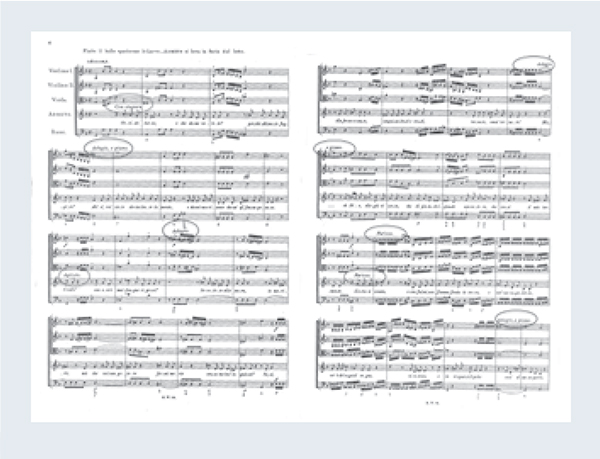 |
| Figure 6: The pages of the dramatic recitative of Handel’s Admeto (1728), which features Admeto singing, “Orride larve”! From G.F. Handel’s Werke: Ausgabe der Deutschen Handel-Gesellschaft, ed. Friedrich Chrysander. Images courtesy of the author. |
The final theme in Handel’s works that I’ll address tonight is religion, a subject of paramount importance in Great Britain at this time. Handel’s penultimate oratorio, Theodora, is a story about the Christian martyr, Theodora. Theodora and Didymus, a former soldier who had secretly converted to Christianity, are both sentenced to death, sacrificed as Christians before the Roman authorities. In their final duet together, they sing of the “Streams of Pleasure ever flowing” that await them when they are “from Life’s dull Labours free.” Earlier in the oratorio, Theodora has already said goodbye to this “fond, flattering world.”
The next year, when composing his last oratorio, Jephtha, Handel began to experience the symptoms that resulted in his blindness. While working on the final chorus at the end of Part II, “How dark, O Lord, are thy decrees,” he wrote in the margin: I was unable to continue my left eye was too weak. He was forced to stop composing for about month. When he returned to work, he was able to complete this chorus, which ends with the words, “What God ordains, is right.” Later, he changed these words to “Whatever is, is right,” taken from Alexander Pope’s “An Essay on Man.” Every time this phrase is sung, it is pounded out in a different key: first in C, then in F, next in E-flat, as if “any” key is harmonically “right.” I find it enormously moving that Handel, as he was losing his sight, set this phrase from Pope to the tune of “Fond, flatt’ring world, adieu.”
As we reviewed these personal stories of Handel and his friends, we explored four aspects of their world, all of which ultimately played a central role in Handel’s music: how these friends made music with one another; found (or failed to find) fulfillment in marriage; fell ill; and exercised their religion. Learning about Handel’s friends helped me to see a reflection of their lives in Handel’s music. Further, it gave me a picture of the Handel they might have known. He visited his neighbor’s houses, trying out their harpsichords. He stayed up late at parties, accompanying at the keyboard for all of the women in attendance who sang. And from 1738 on, his music takes on a very personal sense of expression as he dealt increasingly with physical illness and blindness. All of these sensations, memories, and feelings resonate in his music, and we can still feel them today. Through his music, we are welcomed into Handel’s world.
© 2015 by Ellen T. Harris